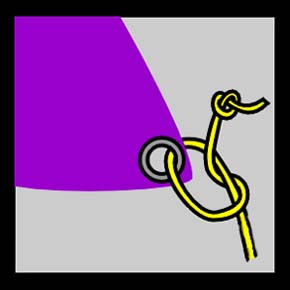|
Radium Release Hitch
A radium release hitch is a load-releasing hitch using 3:1 mechanical advantage which is used in a two-rope technical rescue system. The Radium Release Hitch allows a load to be transferred from one rope to another and is commonly rigged into the belay line prior to the operation of a two-rope technical rescue system. A radium release hitch is typically tied with 10 meters of 8mm rope and two locking carabiners. A reasonable length for the hitch (distance between the 2 carabiners) is 10 to 15 cm. History The Radium Release Hitch was developed by Kirk Mauthner (who lives near Radium Hot Springs, hence the name) as a result of the extensive comparative analysis of release devices undertaken during 1997 through 1999 Usage * Passing knots * Untensioning a locked lowering device or locked up prussiks. Tying * Tie a figure 8 on a bight at one end of the cord and clip it into the load carabiner on its spine side. * Clip the standing part of the rope through the anchor carabi ... [...More Info...] [...Related Items...] OR: [Wikipedia] [Google] [Baidu] |
Mechanical Advantage
Mechanical advantage is a measure of the force amplification achieved by using a tool, mechanical device or machine system. The device trades off input forces against movement to obtain a desired amplification in the output force. The model for this is the ''law of the lever.'' Machine components designed to manage forces and movement in this way are called mechanisms. An ideal mechanism transmits power without adding to or subtracting from it. This means the ideal machine does not include a power source, is frictionless, and is constructed from rigid bodies that do not deflect or wear. The performance of a real system relative to this ideal is expressed in terms of efficiency factors that take into account departures from the ideal. Lever The lever is a movable bar that pivots on a fulcrum attached to or positioned on or across a fixed point. The lever operates by applying forces at different distances from the fulcrum, or pivot. The location of the fulcrum determines ... [...More Info...] [...Related Items...] OR: [Wikipedia] [Google] [Baidu] |
Carabiner
A carabiner or karabiner () is a specialized type of shackle, a metal loop with a spring-loaded gate used to quickly and reversibly connect components, most notably in safety-critical systems. The word is a shortened form of ''Karabinerhaken'' (or also short ''Karabiner''), a German phrase for a "spring hook" used by a carbine rifleman, or carabinier, to attach his carabin to a belt or bandolier. Use Carabiners are widely used in rope-intensive activities such as climbing, fall arrest systems, arboriculture, caving, sailing, hot air ballooning, rope rescue, construction, industrial rope work, window cleaning, whitewater rescue, and acrobatics. They are predominantly made from both steel and aluminium. Those used in sports tend to be of a lighter weight than those used in commercial applications and rope rescue. Often referred to as carabiner-style or as mini-biners, carabiner keyrings and other light-use clips of similar style and design have also become popular. Most ar ... [...More Info...] [...Related Items...] OR: [Wikipedia] [Google] [Baidu] |
Radium Hot Springs (British Columbia)
Radium Hot Springs, informally and commonly called Radium, is a village of 1,339 residents situated in the East Kootenay region of British Columbia. The village is named for the hot springs located in the nearby Kootenay National Park. From Banff, Alberta, it is accessible via Highway 93. The hot springs were named after the radioactive element when an analysis of the water showed that it contained small traces of radon which is a decay product of radium. The radiation dosage from bathing in the pools is inconsequential; approximately from the water for a half-hour bathing, around ten times average background levels. The air concentration of radon is about which is higher than the level () at which mitigation within two years is encouraged at residences; but is also inconsequential (about for a half-hour bathing) from a dose impact perspective. Geography Radium is located 16 km north of the tourist town of Invermere, and 105 km south of Golden, British Columbia. It ... [...More Info...] [...Related Items...] OR: [Wikipedia] [Google] [Baidu] |
Figure-eight Knot
The figure-eight knot or figure-of-eight knot is a type of stopper knot. It is very important in both sailing and rock climbing as a method of stopping ropes from running out of retaining devices. Like the overhand knot, which will jam under strain, often requiring the rope to be cut, the figure-eight will also jam, but is usually more easily undone than the overhand knot. The stevedore knot is the figure-eight knot with two half twists added before the end is finally stuck. Different types Figure-eight loop The figure-eight loop is used like an overhand loop knot. This type of knot can be used in prusik climbing when used in conjunction with a climbing harness, a climbing rope, and locking carabiner designed for climbing, to ascend or descend with minimal equipment and effort. Figure-eight bend The figure-eight bend knot is used to " splice" together two ropes, not necessarily of equal diameter. This knot is tied starting with a loose figure-eight knot on one rope ... [...More Info...] [...Related Items...] OR: [Wikipedia] [Google] [Baidu] |
Munter Hitch
The Munter hitch, also known as the Italian hitch, mezzo barcaiolo or the crossing hitch, is a simple adjustable knot, commonly used by climbers, cavers, and rescuers to control friction in a life-lining or belay system. To climbers, this hitch is also known as HMS, the abbreviation for the German term ''Halbmastwurfsicherung'', meaning ''half clove hitch belay''. This technique can be used with a special "pear-shaped" HMS locking carabiner, or any locking carabiner wide enough to take two turns of the rope. In the late 1950s, three Italian climbers, Mario Bisaccia, Franco Garda and Pietro Gilardoni developed a new belay technique called the "Mezzo Barcaiolo (MB) meaning; "a half of the knot, which is used by the sailors to secure a boat to a bollard in a harbor." The "MB" came to be known as the Munter hitch after Werner Munter, a Swiss mountain guide popularized its use in mountaineering in the 1970s. This hitch was studied and then promoted for its use in the mountains (bein ... [...More Info...] [...Related Items...] OR: [Wikipedia] [Google] [Baidu] |
Overhand Knot
The overhand knot is one of the most fundamental knots, and it forms the basis of many others, including the simple noose, overhand loop, angler's loop, reef knot, fisherman's knot, Half hitch, and water knot. The overhand knot is a stopper, especially when used alone, and hence it is very secure, to the point of jamming badly. It should be used if the knot is intended to be permanent. It is often used to prevent the end of a rope from unraveling. An overhand knot becomes a trefoil knot, a true knot in the mathematical sense, by joining the ends. It can also be adjusted, faired, or mis-tied as a half hitch Tying There are a number of ways to tie the Overhand knot. * Thumb method – create a loop and push the working end through the loop with your thumb. * Overhand method – create a bight, by twisting the hand over at the wrist and sticking your hand in the hole, pinch the working end with your fingers and pull through the loop. Heraldry In heraldry, the overhand knot ... [...More Info...] [...Related Items...] OR: [Wikipedia] [Google] [Baidu] |
List Of Knots
This list of knots includes many alternative names for common knots and lashings. Knot names have evolved over time, and there are many conflicting or confusing naming issues. The overhand knot, for example, is also known as the thumb knot. The figure-eight knot is also known as the Savoy knot or the Flemish knot. A * Adjustable Bend – can be easily lengthened or shortened * Adjustable Grip Hitch – a simple hitch which may easily be shifted up and down the rope while slack *Albright Special – used to tie two different diameters of line together, for instance to tie monofilament to braid *Alpine Butterfly (also known as Butterfly Loop) – a static loop mostly used by mountain climbers and rappellers for securing a carabiner to static rope. * Alternate Ring Hitching – covering a ring in hitching can prevent damage * Anchor Bend – attaching a rope to a ring or similar termination *Angler's Loop – knot which forms a fixed loop. Useful for fine or slippery line, it is ... [...More Info...] [...Related Items...] OR: [Wikipedia] [Google] [Baidu] |




